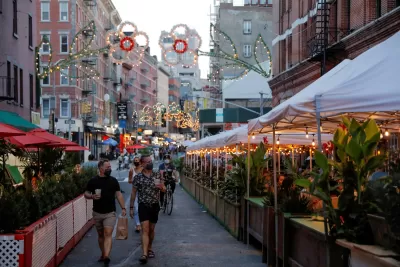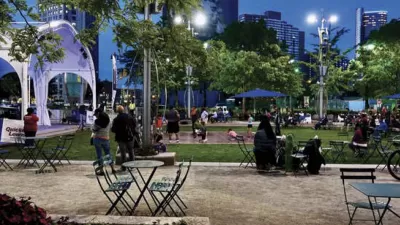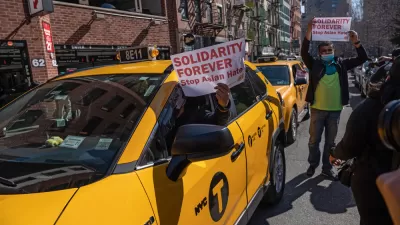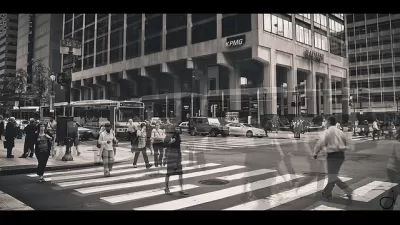Vital urbanism and a prescription for the post-pandemic city.

As the vaccine rolls out and we emerge from social distancing and suspended animation to survey the wreckage, it would be a mistake to return to "normal." The pandemic has brought into sharp relief social inequalities and environmental vulnerabilities in our cities; both are in deep need of repair and reimagination. Rebecca Traister, writing about another (and related) calamity—the storming of the Capitol—wrote "we must steer straight toward the kinds of mechanisms that are this calamity's direct and robust inverse: toward strengthening and empowering a populace, toward a governance that prioritizes dignity and care and safety and security for everyone, not just the already powerful."
To create more just, vibrant, resilient, and sustainable cities—that deliver on "dignity and care and safety and security for everyone"—we must advance five key urban systems.
Housing for Community
In our most prosperous cities, housing supply is infamously constrained, resulting in overwhelming housing insecurity, overcrowding, and homelessness. An excellent place to start curing these ills is by repairing, renewing, and reinventing public housing campuses to make them safe and dignified places to live and raise families. Most of the nation's public housing stock is over 50 years old and ripe for imaginative transformation. There are exciting possibilities to make these "complexes" radically more sustainable, enriched with community resources, welcoming to more residents, and more deeply integrated into their larger contexts.
Seattle's Yesler Terrace is a compelling example. Completed in 1942, Yesler was America's first racially integrated public housing project. Originally built as two-story garden-type apartments, the centrally located site could support many more residents in the now built-up context. A thoughtfully crafted mid-rise, mixed-use, mixed-income master plan is being built out that will eventually yield 5,000 residential units, about nine times the original plan, including triple the original number of subsidized residences.

In New York City, the city's oldest non-profit housing developer, Phipps Houses, is engaged in reimagining and densifying Forest Hills Houses in Queens. Completed in 1975, this three-building, tower-in-the-park development houses 430 families. Phipps is redeveloping the site by adding three more multi-family residential buildings, consolidating parking, and creating more focused outdoor space. The result is 442 affordable units in modern, energy-efficient buildings, on-site medical offices, an expanded community center, and a spacious, well-developed central green space. The existing buildings will be refurbished after this project is complete. Critically, no residents will be displaced.

Transportation for Economic Justice
There is an inverse relationship between income level and commute times: the lower, the longer. Federal intervention to support transit systems straining from the pandemic is a baseline. Now is the time to increase subway, bus, and light rail service to underserved neighborhoods. It is a lesson that needs relearning: robust and extensive mass transit systems promote access to housing, education, employment, healthcare, and the richness of a city's culture for all.
Many North American cities have existing rail rights-of-way that can cost-effectively and quickly be imaginatively restored. In New York, the Regional Plan Association has proposed the Triboro Line, which utilizes 24 miles of abandoned railway tracks stretching from Sunset Park in Brooklyn to Co-op City in the Bronx. Planned for both passengers and freight, it has the potential to become a vital part of the urban transit system for 100,000 daily riders, a catalyst for economic growth, and a string of new recreational spaces. All of this in swaths of diverse neighborhoods beyond Manhattan that have seen persistent underinvestment.

The Workplace Reinvented
Some of us will return to our offices enthusiastically, eager for interaction and face-to-face collaboration. Others will do so reluctantly, mourning the convenience of being more available to family and friends. Most will be in some in-between condition. As workplaces reopen, they will need to embody a greater emphasis on community, wellness, and flexibility. Further, measures that promote resilience to future public health emergencies will be a prerequisite.
1 Willoughby Square (1WSQ), Downtown Brooklyn's first office building in a generation, epitomizes this new ethos. From its unique side core arrangement to the integration of outdoor spaces and its textured design, 1WSQ is designed to promote a sense of place, health, and togetherness, as it welcomes creative workers back to the office.

Civic Infrastructure
Much has been made of Paris mayor Anne Hidalgo's 15-minute city, where everything residents need can be reached within a quarter of an hour by foot or bike. A proven idea that also has compelling branding, it points to a key ingredient of vital cities: robust, distributed networks of small, localized spaces for education, entertainment, community, and health. In medical facilities, for instance, we see a trend away from centralized hospitals to systems of pharmacies, clinics, and outpatient facilities. Housing smaller, distributed facilities in dense urban contexts (that promotes 15-minute living) signals new types of neighborhood building blocks: hybrid buildings.
At the La Central development in the South Bronx, residents of the nearly 1,000 affordable housing units can enjoy an array of amenities within steps of their front doors. These include a new YMCA with pool and gymnasium, rooftop vegetable gardens, a skate park, street-facing retail, and community spaces. A block away is the vibrant Hub of the South Bronx, with access to stores, healthcare, movie theaters, and transportation. The opposite of a gated community, La Central is seamlessly integrated into the surrounding neighborhood's geometry, scale, and materials.


Nature in the City
Our urban parks, streets, and various semi-public and private spaces—from balconies to backyards and roof tops—are critical to maintaining mental, physical, and civic health during quarantine. After the pandemic subsides, I doubt we will readily part from them. Beyond our rekindled love of parks, there is a thirst for a radically expanded and verdant public realm, from living streets to sky gardens. Exciting possibilities are emerging in the overlap of urban design, architecture, landscape architecture, and horticulture.
The New York City Department of Transportation's Open Streets program is fostering experimentation and reinvention of the city's sidewalks, street beds, and intersections that have not been seen in decades. As the ad-hoc installations mature to more permanent conditions, issues of safety, sustainability, and longevity will need to be better addressed. As they evolve, these transformations will be one of the lasting positive—and popular—consequences of the pandemic.

Each one of these five points is vitally important. However, greater transformation comes with interventions that exploit the intersectionality and synergy between them. A roof-top training center for urban agriculture at a mixed-income residential building near transit has more consequential impact than a passive green roof on an affordable housing project.
We can meet this pivotal moment by training our collective attention, creativity, and investment on these five fundamental ingredients, and their amplifying synergies. The result will be more sustainable, safe and inclusive communities, infrastructure, and cities.
Dan Kaplan, FAIA, LEED AP, is a Senior Partner at FXCollaborative, a New York City-based architecture, interiors, and planning design firm. Dan serves in a design and leadership capacity for many of the firm’s complex, award-winning projects. Adept at creating large-scale, high-performance buildings and urban designs, he approaches each project with the mission that it must elevate and resonate with the larger urban, cultural, and climactic totality. Notable projects include 1 Willoughby Square (Brooklyn, New York), Allianz Tower (Istanbul, Turkey), Eleven Times Square (Manhattan, New York), and Fubon Financial Center (Fuzhou, China). Dan holds a Bachelor of Architecture from Cornell University and is a registered architect in numerous U.S. states.

Study: Maui’s Plan to Convert Vacation Rentals to Long-Term Housing Could Cause Nearly $1 Billion Economic Loss
The plan would reduce visitor accommodation by 25,% resulting in 1,900 jobs lost.

North Texas Transit Leaders Tout Benefits of TOD for Growing Region
At a summit focused on transit-oriented development, policymakers discussed how North Texas’ expanded light rail system can serve as a tool for economic growth.

Why Should We Subsidize Public Transportation?
Many public transit agencies face financial stress due to rising costs, declining fare revenue, and declining subsidies. Transit advocates must provide a strong business case for increasing public transit funding.

How to Make US Trains Faster
Changes to boarding platforms and a switch to electric trains could improve U.S. passenger rail service without the added cost of high-speed rail.

Columbia’s Revitalized ‘Loop’ Is a Hub for Local Entrepreneurs
A focus on small businesses is helping a commercial corridor in Columbia, Missouri thrive.

Invasive Insect Threatens Minnesota’s Ash Forests
The Emerald Ash Borer is a rapidly spreading invasive pest threatening Minnesota’s ash trees, and homeowners are encouraged to plant diverse replacement species, avoid moving ash firewood, and monitor for signs of infestation.
Urban Design for Planners 1: Software Tools
This six-course series explores essential urban design concepts using open source software and equips planners with the tools they need to participate fully in the urban design process.
Planning for Universal Design
Learn the tools for implementing Universal Design in planning regulations.
City of Santa Clarita
Ascent Environmental
Institute for Housing and Urban Development Studies (IHS)
City of Grandview
Harvard GSD Executive Education
Toledo-Lucas County Plan Commissions
Salt Lake City
NYU Wagner Graduate School of Public Service





























